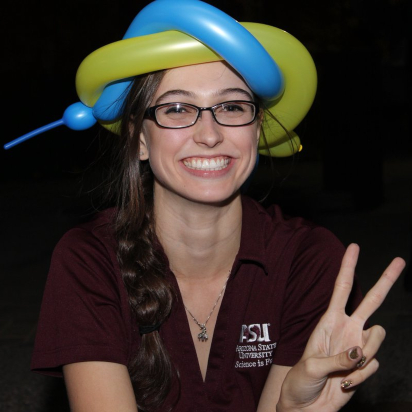Meet Mrs. Batty, a middle school science teacher in Phoenix, Arizona, who also runs an afterschool science club for kids. While my recent conversation with her took place over Zoom due to COVID-19, I try to envision it taking place in Batty's classroom, full of science equipment (most of which she's bought herself) and Batman-themed gifts from students in reference to her last name. She’s enthusiastic about science and learning and always willing to go above and beyond to help her students.
I'm talking with her to understand how genetics is taught in K-12 classrooms. The structure of DNA was discovered less than 70 years ago, and today we're able to sequence an entire human genome in a matter of days and even to edit genomes ourselves using technology such as CRISPR-Cas9. I'm curious to know whether the way we teach genetics has advanced just as quickly as our scientific understanding of the subject.
I start by asking Batty about the genetics concepts she teaches and how she teaches them. She describes genetics as being a difficult, abstract concept to teach. “Anything I can do hands-on, I try to,” Batty explains. She describes various activities she uses with her middle school students: pipe-cleaner chromosome models, DNA extractions with fruit, and mythical-creatures-mash-up Punnett squares. This last one surprises me. I don't remember learning about Punnett squares until high school.
 “I also didn't see them until high school,” Batty says. “That's the problem. Arizona's state science standards don't really list specifics. When I started teaching, I didn't do Punnett squares because I didn't use them until high school. But then I noticed on the science AIMS [Arizona's standardized state test], they had a Punnett square!”
“I also didn't see them until high school,” Batty says. “That's the problem. Arizona's state science standards don't really list specifics. When I started teaching, I didn't do Punnett squares because I didn't use them until high school. But then I noticed on the science AIMS [Arizona's standardized state test], they had a Punnett square!”
“So Punnett squares were on the AIMS but they're not specifically mentioned in Arizona's standards?” I ask.
“No, they’re really vague. And that's my frustration about standards.”
Batty then pulls up the Arizona science standards that reference genetics and lists them.
Adopted in October 2018, the Arizona state science standards aim to make students “scientifically literate” and “college and career ready.” Batty and I talk through the standards relevant to genetics, and when we come to the standard “Communicate how advancements in technology have furthered the field of genetic research and use evidence to argue about the positive and negative effects of genetic research on human lives,” I ask what that is supposed to involve. Batty isn’t sure.
In the absence of any concrete guidance from the standards, Batty explains, she nevertheless attempts to discuss genetic technology and genetics in society. “We use clips from [the personal genomics company] 23andMe, just explaining some of the things they do, after we've covered the basics. But when they start getting into the SNPs [single nucleotide polymorphisms], that seems to be where the kids' brain capacity maxes out,” she says .
So Batty has already gone beyond what the standards dictate, because they really don't give her a lot to go on. How should she decide which genetic technologies to discuss? Which ethical discourses should she include, and which would be frowned upon by the district? How does she delicately approach the political implications of current genetic technology in one of the most contentious eras of American politics? The rapid advancements in genetics technology, combined with unclear state standards and high-stakes standardized testing, makes teaching and learning about genetics difficult in a K-12 classroom.
Glaringly absent from the state standards is the concept of genetic literacy: having the knowledge and ability to understand and make decisions about how genetics influences your everyday life. Such decisions may include whether to pursue genetic counseling in light of the results of an at-home DNA testing kit; whether the privacy risks of sharing your genetic data outweigh the potential health benefits; whether consuming genetically modified foods is safe; and whether the results of a study identifying a gene for alcoholism can be used to develop medical treatments or are sensationalized and unreliable. Rather than rote memorization of content, genetic literacy education focuses primarily on critical reasoning skills related to genetics and its everyday implications.
Arizona’s state science standards only briefly and vaguely touch on the sociocultural components of genetic literacy, as in the standard quoted above, while completely neglecting all epistemic components, such as the certainty and uncertainty of genetic information and the (mis)representation of genetic knowledge in the media. However, these standards are still marginally better than the Next Generation Science Standards (NGSS), which leave out both societal implications of genetics and epistemic knowledge.
For a better example of standards that cover all aspects of genetic literacy, I turned to a seminal article on genetic literacy by Dirk Jan Boerwinkel and his colleagues, “Reaching a Consensus on the Definition of Genetic Literacy that Is Required from a Twenty-First-Century Citizen.” The article defines the purpose of genetic literacy as to supply people with the knowledge to make informed decisions relating to genetics. With its emphasis on genetics in societal contexts, this framework doesn’t dwell on cellular mechanisms such as transcription and meiosis. Knowing that different genes are switched on and off in different cells and that each parent contributes a set of genes to an offspring is sufficient. Instead, this framework focuses more heavily on concepts such as the complex relationship between genes, environment, and traits (knowledge of which is needed, for example, to understand the nuances of media reports on “the discovery of the gene for such-and-such”).


 “I also didn't see them until high school,” Batty says. “That's the problem. Arizona's state science standards don't really list specifics. When I started teaching, I didn't do Punnett squares because I didn't use them until high school. But then I noticed on the science AIMS [Arizona's standardized state test], they had a Punnett square!”
“I also didn't see them until high school,” Batty says. “That's the problem. Arizona's state science standards don't really list specifics. When I started teaching, I didn't do Punnett squares because I didn't use them until high school. But then I noticed on the science AIMS [Arizona's standardized state test], they had a Punnett square!”
